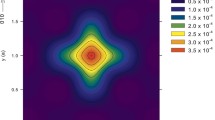Abstract
Two-Dimensional Angular Correlation of positron Annihilation Radiation (2D-ACAR) experiments have been performed on n-type GaAs. By combining these results with those from positron lifetime experiments, the momentum distribution of the arsenic vacancy in its neutral (V 0aAs ) and negative (V −As ) charge states have been extracted. These distributions were all normalized to the respective positron lifetime that characterizes them. The first thing to be noticed is that the momentum distributions of the vacancies, as seen by the positron, are fairly isotropic and structureless. The distribution forV 0As is more peaked than that ofV −As while the latter is more intense in the large momentum regions of the spectra. From this, it can be inferred that VA. has a smaller open volume thanV 0As A closer look at the momentum distribution of the vacancies reveals that they are not entirely isotropic, but, in fact, have a bulk-like component. Finally, the experimental results for bulk GaAs andV −As compare well in a qualitative manner with the momentum distributions that result from an ab-initio molecular dynamics calculation.
Similar content being viewed by others
References
P. Hautojärvi, C. Corbel: InPositron Spectroscopy of Solids, eds. A. Dupasquier and A.P. Mills jr. (IOS Press, Amsterdam 1995)
R. Ambigapathy, A.A. Manuel, P. Hautojärvi, K. Saarinen, C. Corbel: Pbys. Rev. B50, 2188 (1994)
A.A. Manuel, R. Ambigapathy, P. Hautojärvi, K. Saarinen, C. Corbel: J. Phy. (Paris)5, C1–73 (1995)
A.A. Manuel, R. Ambigapathy, P. Hautojärvi, K. Saarinen, C. Corbel: Appl. Surf. Sci.85, 301 (1995)
T. Chiba, A. Kawasuso, M. Hasegawa, M. Suezawa, T. Akahane, K. Sumino: Mat. Sci. Forum175-178, 327 (1995)
J.P. Peng, M.T. Ulmor, K.G. Lynn, D.J. Keeble, D.R. Harshman: Phys. Rev. B50, 11247 (1994)
P.E. Bisson, P. Descouts, A. Dupanloup, A.A. Manuel, E. Perreard, M. Peter, R. Sachot: Helv. Phys. Acta55, 100 (1982)
S. Berko: InPositron Solid-State Physics, ed. by W. Brandt, A. Dupasquier (North-Holland, Amsterdam 1983) p. 581
K. Saarinen, P. Hautojärvi, P. Lanki, C. Corbel: Phys. Rev. B44, 10585 (1991)
K. Laasonen, R. Nieminen, M.J. Puska: Phys. Rev. B45, 4122 (1992)
L. Gilgien, G. Galli, F. Gygi, R. Car: Phys. Rev. Lett.72, 3214 (1994)
Author information
Authors and Affiliations
Rights and permissions
About this article
Cite this article
Ambigapathy, R., Corbel, C., Hautojärvi, P. et al. Using positron 2D-ACAR as a probe of point defects in GaAs: The As vacancy as a case study. Appl. Phys. A 62, 529–532 (1996). https://doi.org/10.1007/BF01571688
Received:
Accepted:
Issue Date:
DOI: https://doi.org/10.1007/BF01571688




